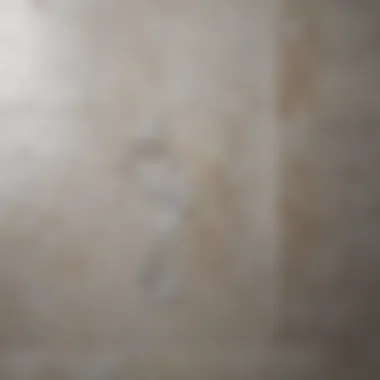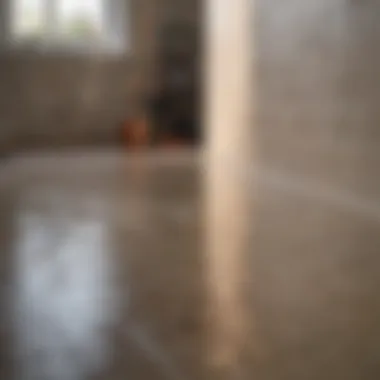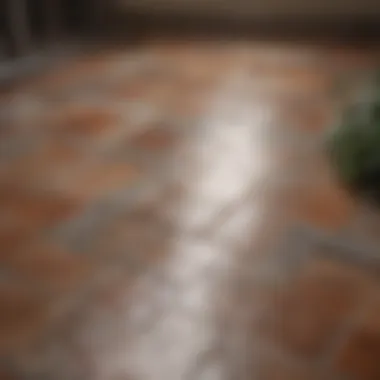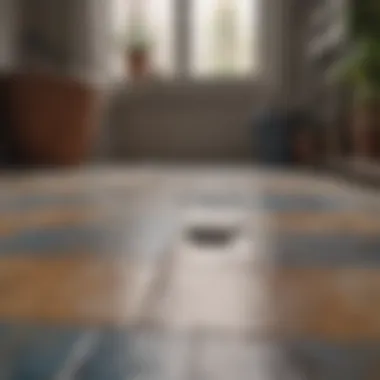Expert Techniques to Eliminate Hard Water Stains from Ceramic Tile


Intro
Hard water is a common issue affecting many households. It leaves behind unsightly stains on ceramic tiles, diminishing the aesthetic appeal of your home. These stains are a result of mineral deposits, primarily calcium and magnesium, that accumulate due to moisture and water quality. Understanding how to effectively remove these stains is essential for homeowners and renters alike. This guide focuses on practical methods to tackle hard water stains, ensuring your ceramic tile surfaces remain clean and inviting.
Maintaining a tidy environment not only enhances the look of your space but also significantly affects property value. In this comprehensive guide, we will explore various cleaning techniques, preventive measures, and the best practices to achieve long-lasting results on ceramic tiles. This information is vital for anyone looking to uphold the beauty of their tiled areas.
Key Insights and Trends
While the effective removal of hard water stains is crucial, integrating current trends in home decor can elevate the overall look of your living spaces.
Current trends in interior design
In recent times, minimalistic and functional design choices have gained popularity. Many homeowners are opting for clean lines and bright, airy spaces. Ceramic tiles, especially those with neutral or pastel colors, complement these trends by adding subtle elegance. Furthermore, the increase in open floor plans means that maintaining the aesthetic appeal of all surfaces, including tiles, is now more critical than ever. Keeping your ceramic tiles spotless not only supports this trend but also enhances the light diffusion within a space.
To keep up with these design choices, selecting tile options with finishes that resist water stains or that are easier to clean can be a worthwhile investment.
Practical Tips and How-To Guides
When it comes to removing hard water stains, employing the right techniques can make all the difference. Here are some recommended practices:
Step-by-step guides for cleaning hard water stains
- Assess the Stains: Begin by evaluating the extent of the stains. Identify areas that require immediate cleaning.
- Gather Supplies: Collect necessary materials such as white vinegar, baking soda, and a non-abrasive scrub pad. These are effective and safe for ceramic tiles.
- Apply the Cleaning Solution: Mix equal parts of water and white vinegar in a spray bottle. Spray the solution onto the stained areas and allow it to sit for at least 15 minutes.
- Scrub Gently: Use the non-abrasive scrub pad to wipe the stained areas, applying gentle pressure. Avoid harsh chemicals or tools, as they may damage the tile finish.
- Rinse Thoroughly: After scrubbing, rinse the area with clean water to remove any residue from the cleaning agents.
- Dry the Surface: Use a soft cloth to dry the tiles immediately. This step helps prevent future stains.
Preventive Measures
To avoid hard water stains from forming in the future, consider these preventive tips:
- Wipe down tiles after use, especially in bathrooms and kitchens, to remove excess moisture.
- Install a water softener to reduce the minerals present in your water supply.
- Regularly clean tiles with a mild detergent to prevent buildup.
"Regular maintenance can save significant efforts in the long run. A proactive approach ensures you won’t face persistent stains on your ceramic tiles."
By applying these techniques and being mindful of preventative practices, homeowners will be able to maintain the visual integrity of their ceramic tiles effectively.
Following this guide will result in cleaner tiled surfaces and contribute positively to the overall ambiance of the home.
Understanding Hard Water Stains
Hard water stains can be a persistent nuisance for many homeowners and renters. They detract from the beauty of ceramic tile surfaces, making them look unkempt. Gaining knowledge about hard water stains is essential, not only for effective cleaning but also for maintaining the overall aesthetic of your living space. By understanding what hard water stains are, you can implement the best strategies to avoid them and know how to address them when they do occur.
What Constitutes Hard Water?
Hard water is water that has a high mineral content, primarily calcium and magnesium. This occurs when water passes through limestone and similar rocks, which dissolve these minerals into the water supply. The definition of hard water can vary based on mineral concentration, but it typically denotes water with more than 60-120 mg of calcium-carbonate per liter.
When hard water is used for household tasks, such as washing dishes or showering, it can leave behind mineral deposits. Over time, these build-up form unsightly stains on ceramic tiles, particularly in areas exposed to water, like bathrooms and kitchens. Recognizing the constituents of hard water helps in understanding its effects on ceramic surfaces.
Sources of Hard Water Stains
Hard water stains mainly arise from water sources that contain high levels of dissolved minerals. Here are some common sources:
- Municipal Water Supplies: Some urban areas receive water that is considered hard straight from treatment facilities. This can lead to significant staining in homes.
- Well Water: Private wells often have minerals that seep from the ground, resulting in hard water.
- Irrigation Systems: Watering gardens or lawns with hard water can also contribute to stains in areas where splashing occurs.
When these sources are part of daily routines, neglecting to address the hard water issue can greatly impact the condition of ceramic tile.
Chemical Composition of Hard Water Deposits


The mineral deposits left by hard water primarily consist of calcium carbonate, magnesium carbonate, and other mineral salts. When water evaporates on the ceramic surface, these minerals crystallize, creating hard water stains. The composition may vary depending on the source of the water and the specific minerals present at that location. This understanding not only assists in identifying the stains but also plays a role in selecting the right cleaning agents that can effectively dissolve these mineral deposits.
In summary, a thorough knowledge of hard water stains helps homeowners and renters to make informed decisions about cleaning methods and preventive strategies. Recognizing the sources and chemical makeup of the stains leads to more effective cleaning solutions and long-lasting maintenance.
Assessing the Damage
Assessing the damage caused by hard water stains is critical in tackling this issue effectively. Understanding the extent of the staining helps in choosing the right cleaning methods and products. Different stains may require different approaches, and overlooking this step could lead to ineffective cleaning strategies.
Evaluating the situation includes not only recognizing the presence of stains but also determining their type and severity. For homeowners, this process sets the tone for subsequent cleaning efforts and can significantly influence the outcome. Additionally, knowing the stain’s origin can inform preventative measures, ensuring a cleaner and more resilient tiled space in the future.
Types of Hard Water Stains
Hard water stains typically manifest in various forms, each associated with specific minerals found in hard water. The most common types include:
- Calcium Deposits: These appear as white, chalky streaks, often accumulating where water is frequently present.
- Magnesium Stains: Slightly darker and sometimes more challenging to remove, these stains can range from yellow to brown.
- Mineral Build-up: This often creates a dull appearance on the tile surface, reducing its shine and beauty.
- Soap Scum: This can be mistaken for hard water stains. It often appears in conjunction with hard water and is a mix of soap and minerals.
Learning to identify these types helps in selecting the appropriate cleaning solution. Each stain type may react differently to various cleaners and techniques.
Identifying Severity of Stains
Identifying the severity of hard water stains is essential for an effective cleaning approach. Stains can range from light surface marks to deep-set discoloration that may require more intensive intervention. Here’s how to assess the severity:
- Visual Inspection: Examine the tile closely. Light stains may barely be visible, while severe stains will disrupt the tile’s smooth surface and finish.
- Touch Test: Gently rub the stained area with a finger. If residue comes off easily, the stain is likely less severe. If the surface feels rough or gritty, deeper cleaning will be necessary.
- Longevity: Consider how long the stains have been present. Older stains are often more embedded, needing more aggressive products or methods.
Understanding both the type and severity of hard water stains ultimately saves time and labor during the cleaning process. This initial assessment leads to wiser choices in cleaning and can prevent damage to tile surfaces in efforts to restore their cleanliness.
Choosing the Right Cleaning Solutions
When dealing with hard water stains on ceramic tiles, choosing the right cleaning solutions is crucial in ensuring effective removal. The market offers a variety of options ranging from natural ingredients to commercial products. Having the appropriate cleaner not only aids in stain removal but also helps protect the tile's surface. Each cleaning option comes with its own set of benefits and considerations, making it important to understand their properties before making a selection.
Natural Cleaning Agents
Natural cleaning agents offer an eco-friendly and safe way to remove hard water stains. They are often easily available and less harsh compared to chemical solutions.
Baking Soda
Baking soda is a well-known cleaning agent highly regarded for its versatility. It exhibits mild abrasive properties, making it effective in scrubbing away stains without scratching the tile surface. It is especially beneficial for individuals looking for a non-toxic solution. One unique feature of baking soda is its ability to absorb odors, which can enhance the overall cleaning experience. However, while it is effective on light stains, severe buildup might require additional scrubbing or the use of stronger agents.
White Vinegar
White vinegar serves as a powerful natural cleaner due to its acetic acid content. This acidity allows it to dissolve minerals that comprise hard water stains, making it a popular choice. The key characteristic of white vinegar is its ability to cut through grime and buildup efficiently. Although it can effectively remove stains and leave tiles shining, the strong odor can be off-putting for some. It is also essential to avoid using vinegar on natural stone tiles, as it can damage the surface.
Lemon Juice
Lemon juice is another effective natural cleaning agent, celebrated for its fresh scent and acidity. Similar to white vinegar, its citric acid helps in breaking down hard water deposits. Lemon juice is a beneficial choice due to its pleasant smell and natural antibacterial properties, which can contribute to overall cleanliness. However, just like vinegar, it is acidic and should be avoided on certain materials, particularly natural stone.
Commercial Cleaning Products
For those who seek more robust options, commercial cleaning products are designed specifically for tough stains and mineral deposits. They provide quick and effective solutions for ceramic tiles and can save time.
Calcium and Lime Removers
Calcium and lime removers are specifically formulated for tackling the mineral deposits found in hard water stains. These products often contain stronger acids that can effectively break down thick buildups. Their targeted approach makes them a beneficial choice for homeowners facing persistent stains. However, care must be taken when using them, as prolonged exposure can damage tile finishes.
Acidic Cleaners


Acidic cleaners are another category that offers effective solutions for removing hard water stains. They work by chemically breaking down the deposits. Their key characteristic is their efficacy in tackling multi-layered stains within a short time. Acidic cleaners can be an asset in the cleaning arsenal, but caution is necessary. They can cause discoloration or etching on delicate surfaces, and protective gear is advised during use.
Enzyme-based Cleaners
Enzyme-based cleaners utilize natural enzymes to break down organic material and mineral deposits. One of the unique features of these cleaners is their non-toxic formulation, making them safe for various surfaces. The key advantage is their environmental friendliness, which is appealing to many homeowners. However, these cleaners might be less effective on stubborn stains compared to acidic options and may require more time for proper results.
Homemade Cleaning Solutions
Homemade cleaning solutions can be an alternative for those preferring a DIY approach. By combining common household ingredients, one can create effective and economical cleaning solutions tailored to specific needs. \n Having the right cleaning solution is essential in addressing hard water stains effectively. Understanding the options available allows individuals to make informed decisions based on preferences and the specific nature of the stains they are dealing with.
Step-by-Step Cleaning Method
Cleaning hard water stains from ceramic tile is a methodical process. A structured approach enhances effectiveness and minimizes damage to the surface. This section outlines the essential steps to ensure optimal cleaning results while considering the nuances of different cleaning solutions and techniques.
Preparation of the Area
Before initiating the cleaning process, it is crucial to effectively prepare the area. Start by removing any movable items, such as furniture and decorative objects, from the tiled space. This ensures that the entire area is accessible and reduces the chances of causing any damage to surrounding materials.
Next, sweep or vacuum the floor to eliminate loose dirt and debris. This step is important because it prevents scratching the tile surface when scrubbing. Additionally, deciding on a time for the cleaning is vital; ensure that there is adequate ventilation in the area to allow for proper drying and to disperse any strong odors from cleaning agents.
Application of the Cleaning Solution
Once the area is prepared, the application of the chosen cleaning solution can commence. Select a cleaning agent based on the type of hard water stains and the severity of the deposits. Depending on your choice—be it a natural solution like vinegar or a commercial cleaner—apply it generously to the stained areas. Allow the solution to sit for a specified duration, as noted in product directions, to maximize its effectiveness. This dwell time enhances the solution's ability to break down the mineral deposits embedded in the tile surface.
Scrubbing Techniques
Appropriate Tools
Choosing the right tools is essential in effective scrubbing. Tools like non-abrasive scrub brushes or sponges are preferred. They remove stains without damaging the ceramic tile's glaze. A brush with strong bristles can be beneficial in reaching porous surfaces. However, one should avoid anything too abrasive, as it may scratch the tiles.
A key characteristic of non-abrasive tools is their gentleness. They effectively lift stains without compromising the integrity of the tile. Consider tools like the O-Cedar EasyWring Microfiber Spin Mop or the Scotch-Brite Non-Scratch Scrub Sponge. These are popular choices for their durability and effectiveness. Their unique features include machine-washable components and ergonomic designs, making them user-friendly while retaining cleaning efficacy.
Scrubbing Patterns
Effective scrubbing patterns can influence the results significantly. It is advisable to scrub in circular motions to cover more surface area. This approach aids in lifting the stains evenly without pushing them deeper into the tile. By maintaining a consistent pattern, the likelihood of missing spots is reduced.
A notable aspect of this technique is fluid motion. This characteristic allows for gentle but effective removal of stains. Circular patterns can be particularly advantageous, as they apply uniform pressure across the tile surface. One downside may be that it could take longer in comparison to aggressive back-and-forth motions, but this method proves crucial for maintaining tile integrity.
Rinsing and Drying
After scrubbing, it is vital to rinse the area thoroughly. Use clean water to wash away any residues of the cleaning solutions and dislodged dirt. Not rinsing properly may lead to streaks or additional stains. After rinsing, dry the surface using a clean, dry towel or allow it to air dry. Proper drying prevents any new hard water stains from forming, as moisture can interact with minerals in the air, creating new deposits. Overall, this method encapsulates an effective approach to cleaning and retaining the aesthetic of ceramic tiles.
Preventing Future Stains
Preventing hard water stains on ceramic tiles is crucial for maintaining the hygiene and aesthetics of any tiled space. Such stains can diminish the beauty of your flooring and cause a series of maintenance challenges over time. By taking proactive measures, you can save time and energy in cleaning, reduce the need for harsh chemicals, and extend the lifespan of your tile.
Regular Cleaning Schedule
Establishing a regular cleaning schedule is one of the most effective ways to prevent hard water stains. Regular cleaning limits the buildup of mineral deposits, making deep cleaning sessions less frequent.
Consider these tips for your schedule:
- Frequency: Aim to clean ceramic tiles weekly. This keeps dirt and mineral accumulation at bay.
- Technique: When cleaning, focus on areas that are prone to water exposure, like around sinks and showers.
- Products: Utilize gentle, pH-balanced cleaners to avoid damaging the tile's finish.
By adhering to this schedule, you'll maintain the integrity of your tiles while ensuring they remain visually appealing.


Use of Water Softeners
Installing a water softener can significantly reduce the hardness of water in your home. Softened water contains fewer minerals that cause stains, leading to cleaner tiles.
Here are some benefits of using water softeners:
- Reduced Build-Up: Softened water prevents the accumulation of lime and calcium on tiles.
- Easier Cleaning: With fewer deposits, you can clean your tiles more effortlessly and effectively.
- Long-term Cost Savings: Investing in a water softener can lead to savings on cleaning products and maintenance costs in the long run.
Before purchasing, consider the size and type of water softener suitable for your home to ensure optimal results.
Sealing Ceramic Tiles
Sealing ceramic tiles is another effective strategy to prevent hard water stains. A quality sealant creates a barrier that repels moisture and substances that could lead to staining.
Consider the following aspects of sealing tiles:
- Choose the Right Sealant: Look for products specifically designed for ceramic tiles for better compatibility and durability.
- Application Timing: Seal your tiles after installing them, and remember to reapply every few years, depending on usage and wear.
- Maintenance: Regularly check the integrity of the sealant, as cracks may require resealing to maintain efficacy.
In summary, preventing hard water stains on ceramic tiles is essential for upkeep and aesthetics. By implementing a regular cleaning schedule, utilizing water softeners, and sealing your tiles, you can create a spotless living environment.
Troubleshooting Common Issues
When it comes to removing hard water stains from ceramic tiles, challenges can arise even with the best cleaning approaches. Understanding how to troubleshoot common issues is critical for achieving optimal results. This section discusses persistent stains and damage to the tile surface, offering practical solutions that can restore the appearance of your ceramic tiles effectively.
Persistent Stains
Persistent stains that do not respond to regular cleaning methods can be frustrating. Often, these stubborn marks are a result of accumulated mineral deposits that have adhered to the ceramic surface over time. To address these issues, consider the following techniques:
- Evaluate Cleaning Agents: Sometimes the products used might not be suitable for the type of stain. Experimenting with different natural or commercial cleaning solutions, like white vinegar or dedicated calcium and lime removers, can yield better results.
- Assess Application Method: How you apply cleaning solutions also plays a vital role. Ensure that you allow the cleaning agent to sit for a sufficient time to enhance its effectiveness on tough stains.
- Introduce Naturally Strong Agents: In cases where normal solutions fail, bringing in more potent agents like a baking soda paste can help. Creating a thick paste with water and applying it directly to the stain might help lift the deposits more effectively.
- Scrubbing Techniques: Utilizing appropriate scrubbing methods can improve outcomes. Use non-abrasive pads to avoid scratching the tile, while applying consistent and firm pressure on the stained area.
"It is often in the persistence of efforts that the best cleaning results are achieved."
Damage to Tile Surface
Even with careful cleaning, there is a risk of damaging the ceramic tile surface during stain removal. Understanding how to prevent and address such damage is essential to maintain the tile’s aesthetic and structural integrity.
- Identifying Damage Types: Start by examining the surface for scratches, dull spots, or discoloration. Damage might occur from improper cleaning tools or overly aggressive scrubbing techniques. Recognizing the issue early can help implement correct measures.
- Restoration Techniques: For minor scratches, using a specialized ceramic tile polish can restore shine and color. Applying a small amount of the polish with a soft cloth can often help revive the surface.
- Regular Maintenance: Engaging in preventive measures is crucial for long-term care. Sealing ceramic tiles can form a protective layer, reducing the chance of stains embedding into the surface.
Finale
In this comprehensive guide, the significance of eradicating hard water stains from ceramic tile surfaces is paramount. Not only do these stains detract from the aesthetic appeal of tiled spaces, but they can also lead to long-term damage if left untreated. Focusing on regular cleaning methods and preventive measures empowers homeowners and renters to maintain the integrity of their tiles.
Advantages of Maintaining Clean Tiles
Clean tiles not only enhance the overall appearance of a space but also contribute to a healthier living environment. Removing hard water stains can prevent mold and mildew, which thrive in damp and neglected corners. Regular maintenance can save time and money in the long run, minimizing the need for professional cleaning services or costly replacements.
Key Considerations
When deciding on cleaning strategies, it is crucial to consider the type of tile and the nature of the stains. Some cleaning agents may be too harsh for certain surfaces, while others may not be effective against severe staining. Therefore, understanding the underlying issue is essential before proceeding with a cleaning solution.
Summary of Best Practices
To conclude, the information provided in this article underlines an effective approach to tackle hard water stains. Key strategies include:
- Regular cleaning schedule to avoid buildup.
- Utilizing appropriate cleaning agents, whether natural or commercial.
- Adopting preventive measures such as sealing tiles or installing water softeners.
Taking these steps will not only improve the aesthetic of your ceramic tiles but also extend their lifespan, ensuring they remain a highlight in your home or rental. Regular attention to tile maintenance will ultimately lead to a cleaner, more inviting space.
Remember, a little effort can lead to significant long-term benefits!
By following this guide, readers can effectively combat hard water stains and preserve the beauty of their ceramic tiles.



